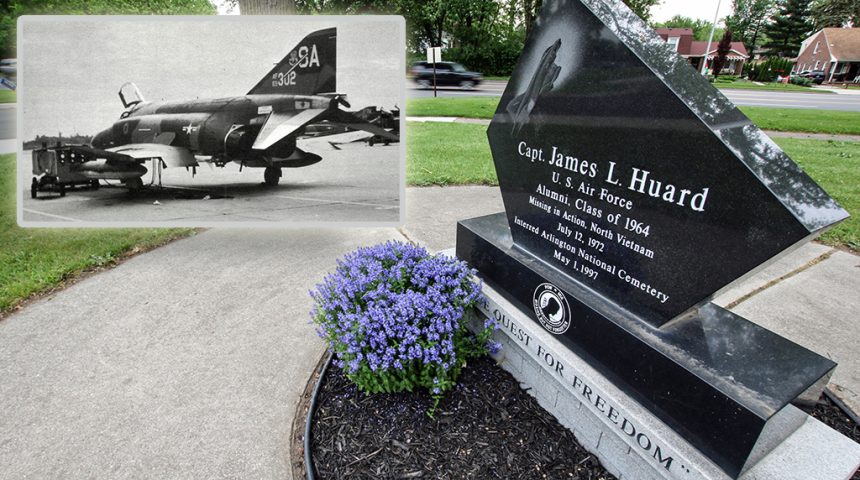Memorials Across the U.S. Remember Our Fallen, And All Too Often We Miss Them.
There are so many military memorials and monuments in the United States that Google doesn’t serve a single index to them all. Perhaps because there are so many, hardly anyone here in my home town of Dearborn, Michigan notices the humble memorial to a remarkable hero that has stood in front of my high school, Dearborn High, since May 1, 1999. That oversight typifies America’s often jaundiced relationship with her military fallen, especially from the Vietnam era. But on Memorial Day 2021, I decided to look more deeply into the memorial that I pass several times every week in my own neighborhood. When I learned the story behind it, I was astounded.
Dearborn native and 1964 Dearborn High School graduate, USAF Captain James L. Huard, was a member of the most daring and innovative group of fighter pilots of the Vietnam era. Certainly one of the most remarkable units in the history of air combat. By all accounts, their exploits are the stuff of legend. These real-life, swashbuckling fighter pilots had the “Right Stuff” in volumes.
Lead by a WWII hero triple-ace, Brig. Gen. Robin Olds, who seemingly fell out of a Hollywood casting call for a leading man (he was later married to a real-life Hollywood starlet), the unit’s history of innovation, unconventional tactics and breathtaking heroism is almost too incredible to believe. But unlike a Hollywood movie starring Tom Cruise, these characters are all very real. And for years a monument to the valor and sacrifice of one of their fallen has stood in front of my High School. I never knew the story of the man behind the monument. Until now.
The story of James Linton Huard is not easy to find by today’s standards of instant information. There are tendrils of his history available through well-worded Google searches, refined keywords, re-searching and reading through government databases. But the links back to this remarkable man and his incredible story are frayed and slow to collate. That is a tragedy. That students come and go every day at Dearborn High School without knowing the full measure of this remarkable man and his amazing life is a missed opportunity.
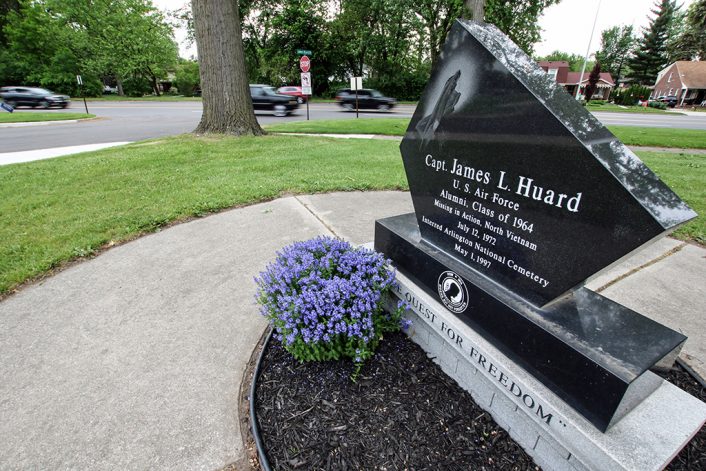
(Photo: TheAviationist/Tom Demerly)
Records show that James “Jim” Huard was active in basketball, track and choir at Dearborn High. Huard was also a devout churchgoer. He got good grades, and after high school he graduated from Central Michigan University in 1968. After college, he began teaching math and science at Dearborn’s Woodworth Middle School on Ternes Street.
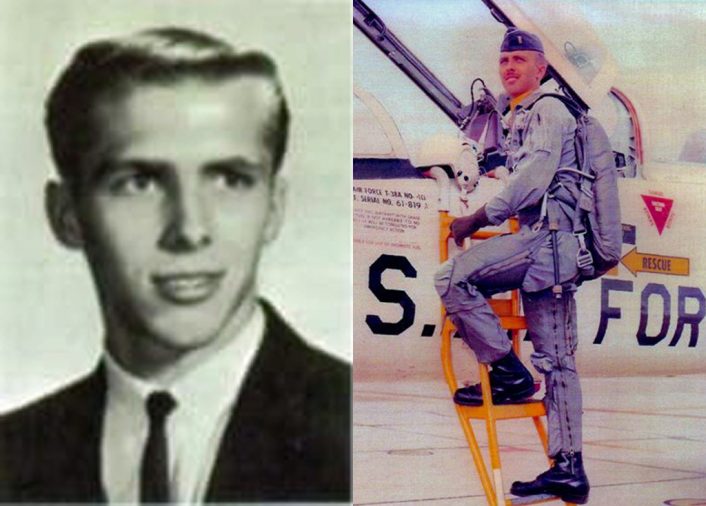
Then something remarkable happened. The seemingly mild-mannered, humble teacher became a tiger. In 1971, after joining the Air Force and excelling at undergraduate pilot training, church-boy James Huard was selected for the elite 433rd Tactical Fighter Squadron (TFS) ‘Satan’s Angels’, 8th Tactical Fighter Wing ‘Wolf Pack’ at Ubon Royal Thai Air Force Base, Thailand. He flew the famous McDonnell Douglas F-4D Phantom II. It was the hottest, deadliest, most capable fighter Mach 2 fighter jet of its time.
Capt. Jim Huard’s unit was led by Brig. Gen. Robin Olds. Among aviation history fans, Olds is legendary. A triple ace who shot down 17 enemy planes in two wars, Olds sported a handlebar moustache and Clark Gabel grin that would have made him a media darling in any conflict in American history- except Vietnam. Because of the controversy that still shrouds the U.S. involvement in Vietnam (called the “American War” by the Vietnamese), men like Capt. Jim Huard and his commander Brig. Gen. Robin Olds remain obscured from mainstream American memory. That myopic view of history is nearly as tragic as the loss of Capt. Jim Ward itself.
On the day he disappeared, July 12, 1972, near the end of his combat tour in Vietnam, Capt. Jim Huard and Capt. Sam O’Donnell Jr. were flying their F-4D Phantom II on a daring, low-level, armed reconnaissance of Quang Khe Ferry Area in North Vietnam’s Quang Binh Province. Previous intelligence had indicated that North Vietnamese troops were using a point in this area as a key supply crossing of the Rao Nay River.
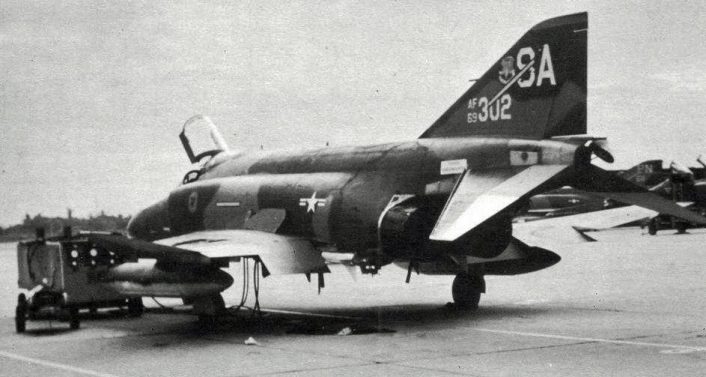
The webpage for Wolf FACs show that Captain Huard was a member of the Wolf FACS but was he tasked out of the 433d TFS.(Image credit: USAF)
According to available accounts, at 07.30 local time, Capt. Huard and Capt. O’Donnell Jr.’s F-4D Phantom II, callsign “Wolf 08”, entered their assigned target area. The crew made routine radio contact with the regional Airborne Battlefield Command and Control Center for targeting instructions. This was to be their last radio communication before disappearing.
Weather conditions over the dense jungle area where Huard and O’Donnell Jr. were flying included scattered clouds between 5,000 and 8,000 feet and visibility of 6 miles. While good conditions for an armed reconnaissance flight, especially by Vietnamese weather standards, these conditions were perhaps even more favorable for North Vietnamese anti-aircraft units hidden in the misty jungle below. These units, who used increasingly sophisticated radar-guided guns and missiles to shoot down American aircraft, had become expert in air defense by 1972, shooting down a staggering 1,737 U.S. aircraft before the war ended on April 30, 1975.
In their last radio communication, Capt. Huard and Capt. O’Donnell Jr. in “Wolf 08” were specifically directed to the river crossing area and enemy traffic along Highway 1 north of the Rao Nay River. At the time of this final call, Huard and O’Donnell Jr.’s F-4D Phantom II was barely west of Highway 1 and about a mile from the Vietnamese coast.
By 0900 Hrs. that day, “Wolf 08” had failed to return to its base in Ubon, Thailand. The duration of its onboard fuel load had run out, and the aircraft had not midair refueled from any of the tanker aircraft in the region. The news was bad.
For three days, a massive search-and-rescue effort with multiple aircraft was mounted to locate Capt. Huard and Capt. O’Donnell Jr. in the North Vietnamese jungle. There were subsequent reports of a faint emergency beacon of the type carried by Huard and O’Donnell Jr. in the region, but they could not be verified as authentic. Huard and O’Donnell Jr. had simply vanished into the Vietnamese jungle.
On Saturday, July 15, 1972, the official search for “Wolf 08” was called off. Capt. Huard and Capt. O’Donnell Jr. were both listed as, “Missing in Action” or MIA. This date would begin 436 days of anguish for Capt. Huard’s wife Cynthia and their three sons, Peter, Daniel and Paul. One year, two months and nine days later on September 24, 1973, James Linton Huard was officially declared as having been, “Killed in Action”.
Years passed with few details about the deaths of Capt. Huard and Capt. O’Donnell Jr. in the North Vietnamese jungle on or about July 12, 1972.
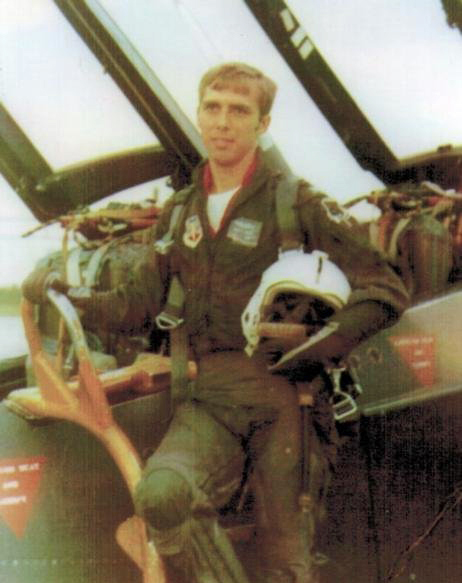
According to the official database on the dpaa.mil website, Capt. James Huard’s remains were returned to the U.S. on December 15, 1988 before they were positively identified. Eight years later, on January 17, 1997, using advanced DNA analysis, these remains were positively identified as belonging to Captain James Linton Huard. On January 29, 1997, his remains were returned to his family. Captain James Linton Huard was finally buried at Arlington National Cemetery on May 1, 1997. It took nearly a quarter of a century, 24 years, 9 months and 19 days, for James Huard to return home and his family to find final closure in the answers to the mystery surrounding his disappearance.
But in October of 2013, Jim Huard’s son, Mr. Paul Rogers, whose last name had changed when he was adopted after his mother remarried, revealed that the family had learned during 2010 that a North Vietnamese army doctor had recovered what was reported as “Capt. James Huard’s helmet” along with photos of the crash site of Huard and O’Donnell Jr.’s F-4D. These photos included what was reported to be an image of Capt. James Huard’s identification card. In cooperation with the new Vietnamese government and the U.S. Air Force, these artifacts were returned to the family in late 2010. The artifacts shed new light on the final moments of Captain James Linton Huard’s life and offered additional comfort to his family.
After learning about the story of Capt. James Huard, it occurred to me that the rather generically named Dearborn High School ought to be rechristened James L. Huard High School, in honor of a loyal Dearborn native who gave his life in pursuit of an ideal and in service to our country.
When I learned the origin of the humble monument in front of my high school and realized that one of these real-life heroes sat in the same classrooms as me, albeit years prior, I was amazed that his story is not more widely known in my home town. There should be books and movies about this man and his brothers in arms. That his story is not more widely known is a tragedy of history’s selective memory and an education system that has difficulty confronting more than a few chapters of American history. That is why, on Memorial Day in the United States, it is worth remembering the stories of men like USAF Captain James Linton Huard and the countless others who have made the supreme sacrifice.
Capt. James Linton Huard is remembered on the Vietnam Memorial Wall in Washington D.C. on Wall Panel 01W at Line 056. Capt. Huard is buried in Section 60, Site 2015 at Arlington National Cemetery. In his hometown of Dearborn, Michigan, the Vietnam Veterans of America Chapter 267 was opened on September, 1986, and named in honor of James Huard. The road in front of Dearborn High School just behind the monument to James Huard has been renamed Capt. James Linton Huard Drive.
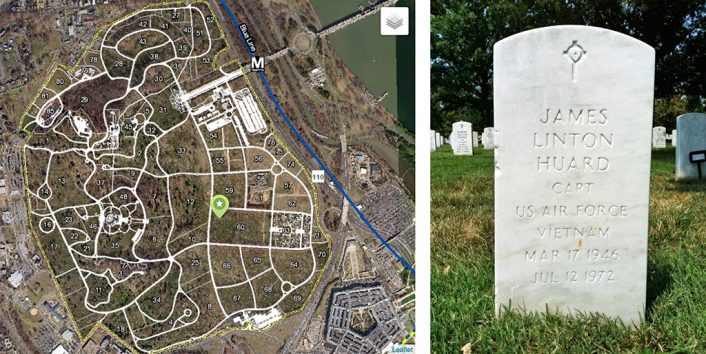
After publishing the first version of this story, we received an interesting comment by John Economidy 8 TFW Information Officer, 1970, who provided some interesting details and raised a really valid point:
“Too much artistic license is taken in crediting 8 TFW commander Robin Olds to the fighting spirit of Wolf FACs and as Captain Huard’s commander. Colonel (later Brigadier General) Olds deserves his recognition but he left Ubon RTAFB in December 1967, some four and a half years before the loss of Captain Huard. When Captain Huard was lost, the Wolf FAC web page lists four persons who could have been Captain Huard’s Wolf FAC commander in August 1972: Mike O’Grady, John Wall, David Yates, or Blaine Jones. Further, after Colonel Olds, the mission of the wing changed from air-to-air to air-to-ground. The 25th TFW specialized in dropping of Igloo White sensors. The 433d TFW was the only unit in SEA using Paveway I laser-guided bombs. The 435th TFW carried Paveway II electro-optical bombs and Walleyes. The 497th TFW had black-painted bellies on its F-4s and flew mainly at night. The Wolfpack had numerous first rate wing commanders after Colonel Olds: Charles “Buck” Patillo, Donald N. “Skip” Stanfield with over 555 career combat missions, David Schmerbeck with 12 aerial kills in Europe in WW II, Lloyd R. “Dick” Leavitt, Larry Killpack, and numerous others. And added to those leadership rolls were James Huard and the officers
and enlisted of the 8 TFW.”

